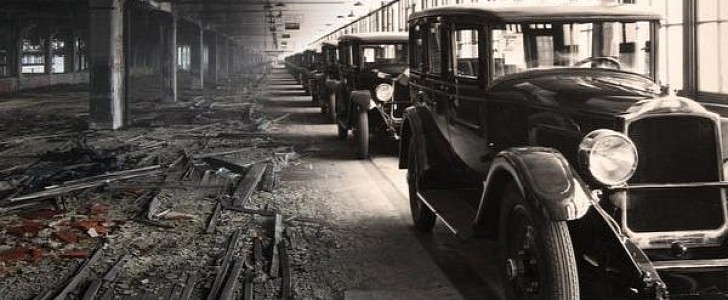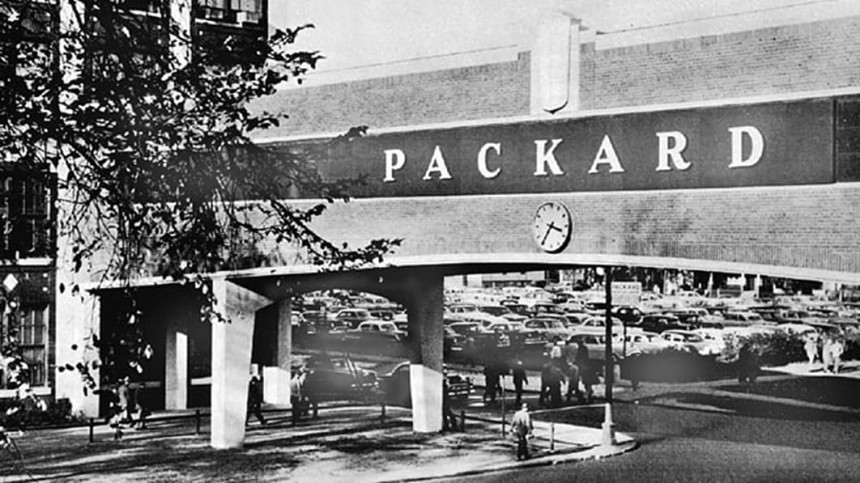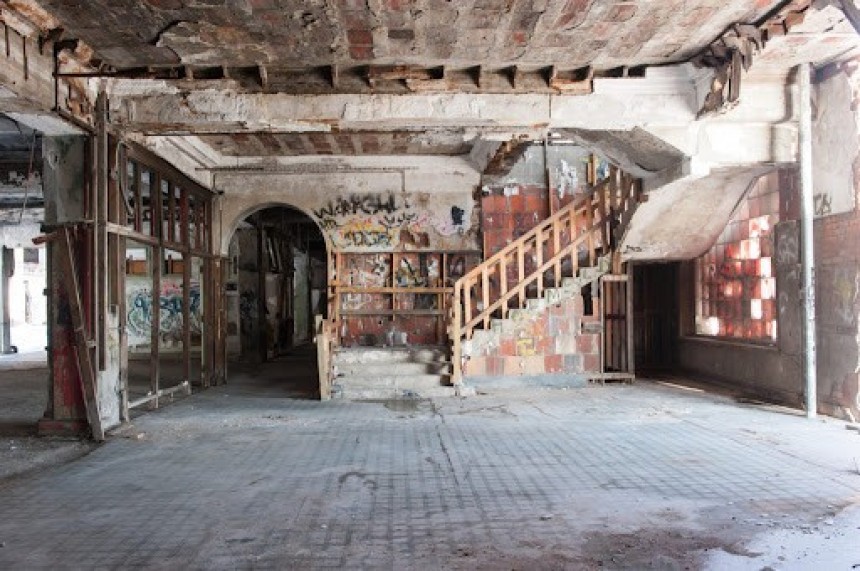In what marked the beginning of the end for the City of Detroit itself as a manufacturing powerhouse, the Packard complex dedicated to the production of the classic marque produced their last vehicle in 1956. The brand name itself was discontinued a couple of years later. Parts of the empty complex were later turned into the Motor City Industrial Park, but it was closed by the City in 1999.
At 3,500,000-square-feet and designed by architectural firm Albert Kahn Associates, the remains of the Packard Plant are located on 40 acres along East Grand Boulevard on the east side of Detroit. The construction of the plant represented the first use of reinforced concrete for industrial construction by the American automobile industry.
Opened in 1903 with 10,000 square feet of floor space, the Packard plant was considered the most cutting-edge automobile manufacturing facility in the world. At the time its modernity, efficiency and massive scale made it a site to behold.
By 1908 the plant was expanded to accommodate the construction of trucks. At that point, it occupied more than fourteen acres of area under roof, and at its peak, the complex employed 40,000 people engaged in more than eighty trades. The plant turned out Packard automobiles from 1903 to 1956 (excepting a lull during World War II). The facility was repurposed to produce war material such as the Packard V-1650 Merlin that was used to power the North American P-51 Mustang fighter plane.
Once the plant closed in 1958, a number of other businesses operated on the premises or rented it for storage until the late 1990s. During the 1990s a number the buildings were used to hold "underground" raves and techno parties.
Now it seems Packard plant property may have a new owner by the end of this year. In the latest news concerning the decades-long plan to revitalize the abandoned site, The Detroit News is reporting that the current owner, Peruvian developer Fernando Palazuelo, is hoping he can sell the site during the next several months. Palazuelo bought the complex from Wayne County for just $405,000 at a tax foreclosure auction in 2003, and during 2017, the developer broke ground on a project aimed at redeveloping the plant for mixed-use. After the initial cleanup, the plant’s iconic bridge collapsed in 2019, and last year, Palazuelo abandoned his plans entirely.
Larry Emmons, a senior managing director for real-estate firm Newmark, says there are developers interested with potential users on board to purchase the site. The property now consists of two 20-acre sites and has a current asking price of $5 million.
For many years, the plant and grounds were left to vandals and scrappers and the site became notorious for its condition and its popularity as a subject of interest to photographers and ‘urbex’ explorers.
Pulitzer Prize-winning poet Philip Levine, one of my personal touchstones as a writer, understood Detroit and factory work in a way many have before him but could not articulate. This was always one of my favorites from him, and it seems particularly relevant in light of the latest news about the Packard Plant.
The gates are chained, the barbed-wire fencing stands,
An iron authority against the snow,
And this grey monument to common sense
Resists the weather. Fears of idle hands,
Of protest, men in league, and of the slow
Corrosion of their minds, still charge this fence.
Beyond, through broken windows one can see
Where the great presses paused between their strokes
And thus remain, in air suspended, caught
In the sure margin of eternity.
The cast-iron wheels have stopped; one counts the spokes
Which movement blurred, the struts inertia fought,
And estimates the loss of human power,
Experienced and slow, the loss of years,
The gradual decay of dignity.
Men lived within these foundries, hour by hour;
Nothing they forged outlived the rusted gears
Which might have served to grind their eulogy.
Opened in 1903 with 10,000 square feet of floor space, the Packard plant was considered the most cutting-edge automobile manufacturing facility in the world. At the time its modernity, efficiency and massive scale made it a site to behold.
By 1908 the plant was expanded to accommodate the construction of trucks. At that point, it occupied more than fourteen acres of area under roof, and at its peak, the complex employed 40,000 people engaged in more than eighty trades. The plant turned out Packard automobiles from 1903 to 1956 (excepting a lull during World War II). The facility was repurposed to produce war material such as the Packard V-1650 Merlin that was used to power the North American P-51 Mustang fighter plane.
Now it seems Packard plant property may have a new owner by the end of this year. In the latest news concerning the decades-long plan to revitalize the abandoned site, The Detroit News is reporting that the current owner, Peruvian developer Fernando Palazuelo, is hoping he can sell the site during the next several months. Palazuelo bought the complex from Wayne County for just $405,000 at a tax foreclosure auction in 2003, and during 2017, the developer broke ground on a project aimed at redeveloping the plant for mixed-use. After the initial cleanup, the plant’s iconic bridge collapsed in 2019, and last year, Palazuelo abandoned his plans entirely.
Larry Emmons, a senior managing director for real-estate firm Newmark, says there are developers interested with potential users on board to purchase the site. The property now consists of two 20-acre sites and has a current asking price of $5 million.
For many years, the plant and grounds were left to vandals and scrappers and the site became notorious for its condition and its popularity as a subject of interest to photographers and ‘urbex’ explorers.
An Abandoned Factory, Detroit
- by Philip LevineThe gates are chained, the barbed-wire fencing stands,
An iron authority against the snow,
And this grey monument to common sense
Resists the weather. Fears of idle hands,
Of protest, men in league, and of the slow
Corrosion of their minds, still charge this fence.
Beyond, through broken windows one can see
Where the great presses paused between their strokes
And thus remain, in air suspended, caught
In the sure margin of eternity.
The cast-iron wheels have stopped; one counts the spokes
Which movement blurred, the struts inertia fought,
And estimates the loss of human power,
Experienced and slow, the loss of years,
The gradual decay of dignity.
Men lived within these foundries, hour by hour;
Nothing they forged outlived the rusted gears
Which might have served to grind their eulogy.
@live.collegiate.shag #abandoned #packardplant #detroit
? original sound - live.collegiate.shag


